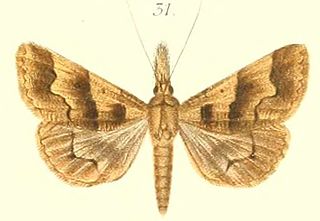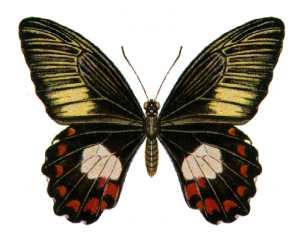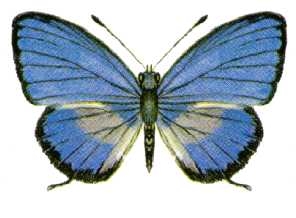
Theretra silhetensis, the brown-banded hunter hawkmoth, is a moth of the family Sphingidae described by Francis Walker in 1856. It lives in Indo-Australia, India, Sri Lanka, Papua New Guinea, East Australia, Solomon Islands, Fiji Islands, Vanuatu Islands.

The continent of Australia, sometimes known in technical contexts by the names Sahul, Australinea, or Meganesia to distinguish it from the country of Australia, consists of the landmasses which sit on Australia's continental plate. The name "Sahul" takes its name from the Sahul Shelf, which is part of the continental shelf of the Australian continent. The continent includes mainland Australia, Tasmania, and the island of New Guinea, which consists of Papua New Guinea and Western New Guinea. Situated in the geographical region of Oceania, Australia is the smallest of the seven traditional continents.

Cocytia is a monotypic moth genus in the family Erebidae. Its only species, Cocytia durvillii, is an uncommon day-flying moth found in lowland areas of the Moluccas, Aru, and New Guinea. The species has clear wings bordered with black, with an orange patch at the base of each forewing and long antennae, thicker at the outer end. Both the genus and species were first described by Jean Baptiste Boisduval in 1828.

Ophyx is a genus of moths of the family Erebidae.

Asota is a genus of moths in the family Erebidae first described by Jacob Hübner in 1819. Species are widely distributed throughout Africa, India, Sri Lanka, Myanmar, the Malayan region and tropical parts of the Australian region.

Asota heliconia is a moth in the family Erebidae. It is found from the Indo-Australian tropics east to Queensland and the Solomons.

Asota plana is a moth in the family Erebidae first described by Francis Walker in 1854. It is found from the Oriental tropics east to New Guinea.
Asota strigosa is a moth of the family Erebidae first described by Jean Baptiste Boisduval in 1832. It is found in Indonesia and the Papua New Guinea.

Asota plaginota is a moth of the family Erebidae first described by Arthur Gardiner Butler in 1875. It is found in China, India, Indonesia, Myanmar, Malaysia, Nepal, Papua New Guinea, the Philippines, Sikkim, Singapore, Sri Lanka, Thailand and Vietnam.
Asota orbona is a moth of the family Erebidae first described by Samuel Constantinus Snellen van Vollenhoven in 1863. It is found in Indonesia, Papua New Guinea and Queensland.
Asota alienata is a moth of the family Erebidae first described by Francis Walker in 1864. It is found in Papua New Guinea and the New Hebrides.
Asota eusemioides is a moth of the family Erebidae first described by Felder in 1874. It is found in Papua New Guinea and Indonesia.
Asota isthmia is a moth of the family Erebidae first described by Francis Walker in 1856. It is found in China, Indonesia, Papua New Guinea and the Philippines.
A. australis may refer to:

Papilio ambrax, the Ambrax butterfly, is a butterfly of the family Papilionidae. It is found in Queensland, Australia, as well as the Aru Islands, Papua (Indonesia), and Papua New Guinea.

Nacaduba cyanea, the tailed green-banded line-blue, is a species of butterfly in the family Lycaenidae, and formerly considered a member of the genus Danis. It is found in the Indonesia, Papua New Guinea, the Solomon Islands and Australia (Queensland).

Acalolepta australis is a species of flat-faced longhorn beetle belonging to the family Cerambycidae, subfamily Lamiinae.
Nyctemera evergista is a moth of the family Erebidae first described by Stoll in 1781. It is found on the Moluccas, Seram, Buru and in New Guinea.
Spilarctia costata is a moth in the family Erebidae. It was described by Jean Baptiste Boisduval in 1832. It is found in Papua, Papua New Guinea and on the Bismarck Archipelago.









